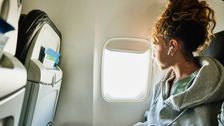It’s hard to beat the speed and convenience of air travel. Over the course of mere hours, you can traverse thousands of miles over multiple countries.
But sitting in a metal tube in the sky for prolonged periods is not always the most comfortable experience. You have to deal with cramped seats, circulation issues, germs and other less-than-ideal factors.
And then of course, there’s the dreaded effect on your ear ― that uncomfortable and sometimes painful pressure. This phenomenon is so common it even has a name: airplane ear.
Below, doctors break down what you need to know about airplane ear, how to prevent it, and what to do if it won’t go away after you reach the ground.
What is airplane ear?
“Airplane ear is a condition that is caused by a difference in air pressure between the inner ear and the surrounding environment during air travel,” said Dr. John Whyte, chief medical officer at WebMD.
The phenomenon is also known as ear barotrauma, barotitis media or aerotitis media.
“It typically happens during takeoff or landing, causing discomfort and pain in the ears,” Whyte said. “The pressure changes can lead to the eardrum becoming stretched or, in rare cases, even ruptured. This causes pain, which can present as the ears feeling clogged or popping.”
Certain factors can exacerbate symptoms, like having sinus congestion, respiratory infection or allergies. Parts of the ear don’t function as well when you have a stuffy nose, for instance.
“Young kids have a harder time since their ear canals are much smaller,” Whyte said.
Basically, the pain or stress you feel on your ear stems comes from a lack of balance between the air pressure in your ear and in the cabin.
“When the airplane descends, the pressure in the cabin increases,” said Dr. Bradley B. Block, an otolaryngologist-head and neck surgeon and host of the “Physician’s Guide to Doctoring” podcast. “The pressure in your middle ear ― that space behind the ear drum where your ear bones are ― needs to increase as well so it is the same as the surrounding, or ambient, environment. There is a tube that connects the middle ear to the back of the nose called the eustachian tube. This is usually closed and we need to open it in order to get air into the middle ear so the pressure is the same as the airplane cabin.”
What can you do for airplane ear?
“Ways to open the eustachian tube include swallowing, yawning and blowing the nose,” Block said. “Sometimes lozenges or gum are…
Click Here to Read the Full Original Article at Travel – Top Destinations, Vacation Ideas…
